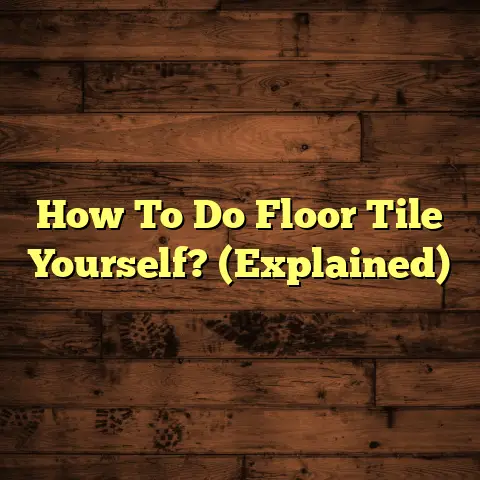How to Lay Porcelain Plank Tile? (1-Day Install?)
I’m thrilled to share my expertise on a flooring trend that’s been taking the design world by storm: porcelain plank tile.
I’ve seen firsthand how these tiles can transform a space, blending the rustic charm of wood with the unmatched durability of porcelain.
What’s even better? You can achieve this stunning makeover in just one day!
That’s right, a 1-day install is totally achievable with the right preparation and a bit of elbow grease.
Let’s dive into why porcelain plank tile is a game-changer and how you can pull off this quick and satisfying project.
Introduction
Porcelain plank tile has become a staple
in modern interior design, and for good
reason.
It’s incredibly versatile, offering
a wide range of styles that mimic natural
wood, from rustic farmhouse to sleek,
contemporary looks.
But it’s not just about aesthetics; these tiles are incredibly durable, standing up to heavy foot traffic, moisture, and everyday wear and tear.
I’ve seen homeowners increasingly choose porcelain plank tiles because they offer the best of both worlds: the beauty of wood without the high maintenance.
Think about it: no more worrying about scratches from pets, water damage in the bathroom, or fading from sunlight.
And let’s be honest, who doesn’t love a quick home renovation?
The idea of a “1-day install” is a game-
changer for busy homeowners and DIYers
alike.
It’s all about maximizing your time
and getting that instant gratification of
a completed project.
I’m here to guide you through the process, making it accessible and enjoyable, even if you’re a beginner.
So, are you ready to transform your space
in just one day?
Let’s get started!
Section 1: Understanding Porcelain Plank Tile
Definition and Composition
What exactly is porcelain plank tile?
Well, it’s a type of ceramic tile made from a specific blend of fine clays and minerals, fired at extremely high temperatures.
This process makes it incredibly dense, hard, and less porous than traditional ceramic tile.
Think of it as the superhero of the tile world!
The key difference lies in its composition and
manufacturing process.
Porcelain tiles have a
water absorption rate of 0.5% or less, making
them virtually waterproof.
This is crucial for areas prone to moisture, like bathrooms and kitchens.
Benefits
Now, let’s talk about why porcelain plank
tile is such a popular choice.
I’ve seen
these benefits play out in countless projects:
-
Aesthetic Versatility: The variety of designs and colors is simply amazing.
You can find tiles that mimic almost any type of wood, from classic oak to exotic teak, and even distressed or reclaimed wood looks.
This allows you to create the exact vibe you’re going for, whether it’s cozy and rustic or modern and minimalist.
-
Durability and Resistance: This is where porcelain plank tile really shines.
It’s incredibly resistant to scratches, moisture, stains, and fading.
I’ve seen it hold up beautifully in high- traffic areas and homes with pets and kids.
It’s a true workhorse!
-
Ease of Maintenance: Say goodbye to tedious cleaning routines.
Porcelain plank tile is super easy to clean with just a damp mop and mild detergent.
No special treatments or sealants are required (although sealing the grout is always a good idea).
-
Eco-Friendliness and Sustainability: Many porcelain tiles are made with recycled materials and are free of harmful VOCs (volatile organic compounds).
Plus, their long lifespan means you won’t have to replace them as often, reducing waste.
Popular Applications
Where can you use porcelain plank tile?
The possibilities are endless! I’ve installed it in:
-
Living Rooms: Creates a warm and inviting space with the look of hardwood but without the worry of scratches or dents.
-
Kitchens: Perfect for resisting spills and standing up to heavy foot traffic.
-
Bathrooms: Its waterproof nature makes it ideal for showers, floors, and even walls.
-
Commercial Spaces: Its durability and low maintenance make it a great choice for businesses like restaurants, offices, and retail stores.
I’ve even seen it used outdoors in covered patios and decks!
Section 2: Preparation for Installation
Okay, now that you’re convinced about the awesomeness of porcelain plank tile, let’s get down to the nitty-gritty: preparation.
This is arguably the most important step in achieving a successful 1-day install.
Trust me, proper preparation will save you time, money, and a whole lot of frustration in the long run.
Tools and Materials Needed
Here’s a comprehensive list of the tools
and materials you’ll need.
I always recommend
gathering everything beforehand to avoid
mid-project scrambling:
-
Tile Cutter: A wet saw is ideal for making clean, precise cuts, especially for porcelain tile.
I prefer using a saw with a diamond blade.
-
Level: A must-have for ensuring your tiles are perfectly level and prevent uneven surfaces.
-
Trowel: Choose the right trowel size based on the tile size and manufacturer’s recommendations.
A notched trowel is essential for creating the proper mortar bed.
-
Spacers: These little guys ensure consistent grout lines and a professional finish.
-
Grout: Select a grout color that complements your tile and suits your style.
I often use epoxy grout for its superior stain resistance.
-
Thin-Set Mortar: This is the adhesive that bonds the tile to the subfloor.
Choose a high-quality mortar specifically designed for porcelain tile.
-
Measuring Tape: Essential for accurate measurements and planning your layout.
-
Safety Gear: Don’t forget safety glasses, gloves, and a dust mask to protect yourself during the installation process.
-
Other Essentials: Buckets, sponges, a utility knife, a pencil, and a rubber grout float will also come in handy.
Subfloor Assessment
Your subfloor is the foundation of your
entire tile installation.
If it’s not in
good condition, your tiles will be prone
to cracking, shifting, and other problems.
Here’s how to assess your subfloor:
Checking for Moisture Levels: Use a moisture meter to check the moisture content of your subfloor.
Excessive moisture can weaken the mortar bond and lead to mold growth.
According to the Tile Council of North America (TCNA), the moisture content of wood subfloors should be no more than 12%.
(TCNA Handbook)-
Ensuring the Subfloor is Clean, Dry, and Structurally Sound: Remove any debris, dust, or old adhesive from the subfloor.
Use a scraper or vacuum to ensure it’s completely clean.
Check for any cracks, loose boards, or uneven spots.
Repair or replace any damaged areas before proceeding.
I often use self-leveling compound to create a perfectly flat surface.
Calculating Tile Needs
Accurately calculating your tile needs is crucial to avoid running out of materials mid-project or ending up with excessive waste.
Here’s how to do it:
-
Measure the Area: Measure the length and width of the area you’ll be tiling.
Multiply these measurements to get the total square footage.
-
Account for Waste: Add an extra 10-15% to your total square footage to account for cuts, breakage, and mistakes.
I always err on the side of caution and add a bit more, especially if the area has irregular shapes or angles.
-
Calculate Tile Quantity: Divide the total square footage (including waste) by the square footage of a single tile.
This will give you the number of tiles you need to purchase.
Don’t forget to factor in the grout line width when calculating the square footage of a single tile.
Section 3: Laying the Tile
Alright, the moment you’ve been waiting for!
Let’s get those tiles laid.
Remember, a
successful 1-day install is all about
efficiency and attention to detail.
Step-by-Step Installation Process
Step 1: Planning the Layout: Before you start slapping down mortar, take some time to plan your layout.
This will help you avoid small cuts at the edges and achieve a visually appealing pattern.-
Staggered Pattern: This is a classic and popular choice for plank tiles.
Stagger the tiles by 1/3 or 1/2 of their length to create a natural, wood-like look.
I like to use a random stagger for a more organic feel.
-
Dry Lay: Lay out a few rows of tiles without mortar to get a feel for the layout and make any necessary adjustments.
This is also a good time to identify any areas where you’ll need to make cuts.
-
Avoid Small Cuts: Try to avoid small cuts (less than half a tile) at the edges.
These can look awkward and be difficult to install.
Adjust your layout to ensure that the edge tiles are at least half a tile wide.
-
Step 2: Applying Thin-Set Mortar: Now it’s time to get messy!
Mix your thin-set mortar according to the manufacturer’s instructions.-
Consistency: The mortar should have a smooth, creamy consistency, like peanut butter.
Too thick, and it will be difficult to spread.
Too thin, and it won’t provide adequate support for the tiles.
-
Application: Use your notched trowel to apply the mortar to the subfloor at a 45-degree angle.
Apply enough mortar to cover a small area (about 2-3 tiles at a time) to prevent it from drying out.
Hold the trowel at a consistent angle to create uniform ridges in the mortar.
-
-
Step 3: Laying the Tiles: Gently place the first tile onto the mortar bed, aligning it with your layout lines.
-
Leveling: Use a level to ensure that the tile is perfectly level.
If it’s not, gently tap it with a rubber mallet to adjust its position.
-
Spacers: Insert spacers between the tile and adjacent tiles to maintain consistent grout lines.
-
Cutting Tiles: Use your wet saw to cut tiles as needed to fit around walls, corners, and other obstacles.
Always measure and mark your cuts carefully before cutting.
I like to use a tile nipper for small, irregular cuts.
-
-
Step 4: Continuing the Installation: Continue laying tiles, maintaining alignment and spacing, and checking for levelness throughout.
-
Alignment: Use a straight edge to ensure that the tiles are properly aligned.
Adjust their position as needed to maintain a consistent pattern.
-
Spacing: Double-check the spacing between tiles to ensure that the grout lines are uniform.
-
Levelness: Use a level to check the levelness of the tiles every few rows.
Adjust their position as needed to create a flat, even surface.
-
-
Step 5: Grouting: Once the tiles are set (usually after 24-48 hours), it’s time to grout.
-
Mixing: Mix your grout according to the manufacturer’s instructions.
The grout should have a smooth, creamy consistency.
-
Application: Use a rubber grout float to apply the grout to the tile surface, working it into the grout lines at a 45-degree angle.
Remove excess grout from the tile surface with the edge of the float.
-
Cleaning: After about 15-30 minutes, use a damp sponge to clean the excess grout from the tile surface.
Rinse the sponge frequently in clean water.
Be careful not to remove too much grout from the grout lines.
-
Hazing: After the grout has dried completely (usually after 24 hours), use a dry cloth to remove any remaining grout haze from the tile surface.
-
-
Step 6: Sealing: Sealing the grout is highly recommended to protect it from stains, moisture, and mildew.
-
Application: Apply a grout sealer according to the manufacturer’s instructions.
Use a small brush or applicator to apply the sealer to the grout lines.
Wipe off any excess sealer from the tile surface with a clean cloth.
-
Tile Sealing: While porcelain tile is naturally water-resistant, sealing it can provide an extra layer of protection, especially in high-moisture areas.
Consult the tile manufacturer’s recommendations for sealing.
-
Section 4: Final Touches and Maintenance
You’re almost there!
Now for the finishing
touches that will make your porcelain plank
tile installation truly shine.
Finishing Touches
-
Baseboards: Install baseboards along the perimeter of the room to cover the gap between the tile and the wall.
Choose baseboards that complement your tile and overall decor.
-
Transitions: Use transition strips to seamlessly connect the tile to other flooring materials, such as carpet or hardwood.
These strips also help to prevent tripping hazards.
Curing Time
Allow the tiles to cure properly before heavy
foot traffic.
This typically takes 24-72 hours,
depending on the mortar and grout used.
I always recommend waiting the full 72 hours to ensure a strong, durable bond.
Maintenance Tips
-
Cleaning Products: Use a mild detergent and warm water to clean your porcelain plank tiles.
Avoid using abrasive cleaners or scouring pads, as these can scratch the tile surface.
I recommend using a pH-neutral cleaner specifically designed for tile.
-
Avoiding Damage: While porcelain tile is durable, it’s not indestructible.
Avoid dropping heavy objects on the tile surface, and use furniture pads to protect it from scratches.
Wipe up spills immediately to prevent staining.
Section 5: Real-Life Examples and Case Studies
Let’s take a look at some real-life examples of successful 1-day installations of porcelain plank tile.
Case Studies
-
Home Renovation: A homeowner transformed their outdated kitchen in just one day by installing porcelain plank tile that mimicked reclaimed wood.
The result was a stunning, rustic-chic kitchen that was both beautiful and functional.
-
Bathroom Remodel: A family updated their bathroom with porcelain plank tile that resembled natural stone.
The waterproof nature of the tile made it perfect for the shower and floor, creating a spa-like oasis.
-
Commercial Space: A local coffee shop installed porcelain plank tile that looked like distressed hardwood.
The durability and low maintenance of the tile made it ideal for the high-traffic environment, while the stylish look added to the shop’s ambiance.
Before and After Images
(Imagine before and after images here, showcasing the dramatic transformation achieved through porcelain plank tile installation)
Conclusion
So there you have it!
Porcelain plank tile
is a fantastic flooring option that combines
beauty, durability, and practicality.
And with the right preparation and a bit of effort, you can achieve a stunning 1-day installation that will transform your space.
I encourage you to consider this flooring option for your next renovation project.
You’ll be amazed at the difference it can make!





